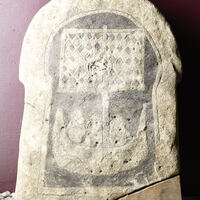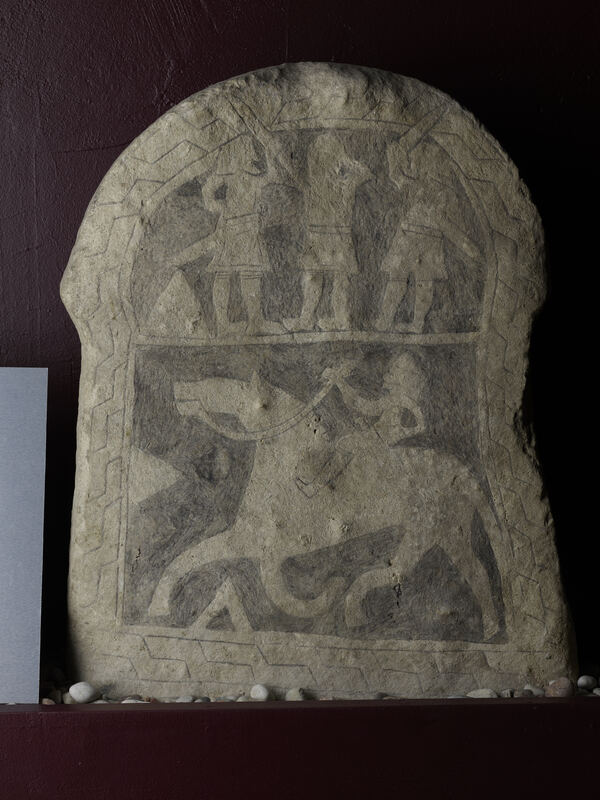GP 79 Etelhem Järnvägslinje














mer grejer




0.0
| Plane | Position | Flip |
| Show planes | Show edges |
Parish Find Location Etelhem
Find Location Along the railway line in Etelhem, Etelhem parish.
Find Context Classification Other
Present Location Classification Gotlands Museum Fornsalen
Coordinate Present Location (lat) 6393355
Coordinate Present Location (long) 696536
Material Limestone
Limestone Type fine limestone without reef debris
Geological Group Slite Group (40%)
Height 68
Width 45
Thickness 6
Lindqvist Type B (ca. 500-700)C/D (ca. 700-1000)
Lindqvist Shape Dwarf stone
Context and Discovery The picture stone was found in 1879 during the construction of the railway line in Etelhem, Etelhem parish (Lindqvist 1941/42 II, p. 42). More information about the find spot and find circumstances are not available.
Measurements, Material and Condition “Limestone slab, fine-grained, sandstone-like, 5 cm thick. The obverse probably is naturally smooth, curved. The narrow sides dressed at right angles towards the obverse, the reverse rough. Height 68 cm, 55 cm of which measured from the lower edge of the decoration. Width between the edges 43 cm, at the neck 39 cm, at the basis 45 cm. The decoration is executed very shallowly, with fine lines and slightly chiselled background fields. In part, as in the case of the horse’s front legs, the patterns and figures appear to have been defined by chiselling away merely the background fields immediately surrounding them” (Lindqvist 1941/42 II, p. 42). Nevertheless, the carvings are well discernible, the surface is not weathered.
Description of Ornament and Images “The field is surrounded by a border filled with a simplified twisted cord pattern and is divided into two halves by a horizontal band. The upper part features a triangle not chiselled away down to the background field [in the left corner, rising from the bottom of the panel] and three men with belts and knee-length tunics; the outer men, their swords drawn, appear to attack the one standing in the middle, who probably lacks any weapons. In the lower field, there are two more triangles left standing [one rising from the bottom, just between the horse’s forelegs, and the other one protruding from the left edge border] and a horseman with sword and pointed cap, but no shield” (Lindqvist 1941/42 II, p. 43). This description corresponds to Lindqvist’s photo of the painted stone published in “Gotlands Bildsteine” (ibid. I, fig. 64; cf. ATA 1648:70, H. Faith-Ell 1933; photo without paint: ATA 186:4).
According to Olof Sörling’s drawing dating to 1917 (ibid. II, fig. 350), the man in the middle of the upper panel appears to be armed as well; a possible blade or scabbard protrudes from his right shoulder. Apart from that, the drawing corresponds to Lindqvist’s image (ibid. I, fig. 64). There are some remarkable finely carved details that depict the horseman’s sword, the warrior’s belts, tunics, parts of the leg bindings, and even the hair of the left swordsmen. The depiction of the horseman is remarkable as well, providing interesting insights into Late Iron Age horse riding technique (ibid. I, pp. 82–83) – the rider is sitting on a relatively huge horse, in reclined position, with horizontal upper legs and the lower leg at the horse’s shoulder. The reins in the equestrian’s hand are leading from the horse’s mouth (snaffle bit).
Interpretation of the Imagery No interpretation
Type and Dating Lindqvist (1941/42 I, p. 38) labels the stone as Type B monument, dating between AD 500 and 700, however, without giving any reasons for this view. Only the stone’s small size and the typical step or geometrized twisted cord pattern might be used as arguments. Iconography, carving technique, and the mushroom shape of the slab do rather indicate a Late Type picture stone, i.e. Type C/D, dating to the 8th–10th centuries. The outline shape is comparable to the stocky Type C/D dwarf stone GP 161 Halla Broa III for instance. The primitive step pattern, which is indeed typical for Type B stones, does occasionally occur in ʻAbschnittʼ C/D as well, as on GP 212 Klinte Hunninge IV (Klintebys). Horsemen and warriors with uplifted swords are frequent Type C/D motives. According to Lindqvist’s interpretation, two swordsmen flanking and attacking a figure (a woman in this case) between them, placed in the uppermost panel of a picture stone, are also depicted on the Late Type monument GP 253 Lärbro St. Hammars I. The finely carved lines on the Etelhem stone, depicting details of dress, weapons and body parts, probably to be regarded as preliminary sketches, do also represent typical Type C/D features. Oehrl regards the Etelhem stone (as well as GP 13 Alva Bopparve) as a late Type B stone, perhaps representing a transitional form between the groups of middle and late type picture stones, presumably dating to the 8th century or even later (2019a, pp. 11, 18, 227). Basically, however, there is hardly any reason to see anything else in those stones than Type C/D stones.
According to Rundkvist’s (2012) typology, the stone’s shape represents Type dwarf4 which occurs in his periods 4–7, i.e., between the Late Vendel Period and the Late Viking Period (8th to 11th century).  GP 161 Halla Broa III
GP 161 Halla Broa III GP 212 Klinte Hunninge (IV) (Klintebys)
GP 212 Klinte Hunninge (IV) (Klintebys) GP 253 Lärbro Stora Hammars I
GP 253 Lärbro Stora Hammars I GP 13 Alva Bopparve
GP 13 Alva Bopparve
References Lindqvist 1941/42 I, pp. 82–83, fig. 64; II, pp. 42–43, fig. 350; Guber 2011, pp. 64–65, fig. 27, 29, p. 116 cat. no. 14; Oehrl 2019a, pp. 11, 18, 227, pl. 2h.
Påträffades 1879 i samband med järnvägsbygge i Etelhems socken, men oklart var i socknen.
Nuvarande lokalisering
Gotlands museum, Bildstenshallen.
Beskrivning
Helt bevarad dvärgsten (period B eller mer troligt period C/D), 68 cm hög och som bredast 45 cm. Kantdekor bevarad, liksom två bildfält. Det övre bildfältet med tre stående män och en triangel, de båda yttre med dragna svärd, men personen i mitten utan vapen. Det nedre bildfältet en ryttare med svärd men ingen sköld och två trianglar.
Datering
Dateringen oklar, men den tillhör perioden 500-900-talen, förmodligen period 700-900-talen.
Tolkning
Ingen tolkning.
AA
TitleGP 79 Etelhem Järnvägslinje
Gotlands Museum ID GFA2264
Jan Peder Lamm ID 55
Lindqvist Title Etelhem, Eisenbahnlinie
Last modified Aug 26, 2025


